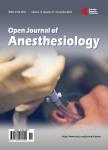Efficacy of Intravenous versus Intrathecal Meperidine on Post-Spinal Shivering after Knee Arthroscopy: A Randomized Controlled Study
Efficacy of Intravenous versus Intrathecal Meperidine on Post-Spinal Shivering after Knee Arthroscopy: A Randomized Controlled Study作者机构:Anaesthesia Department Benha University Benha Egypt
出 版 物:《Open Journal of Anesthesiology》 (麻醉学期刊(英文))
年 卷 期:2022年第12卷第6期
页 面:197-209页
学科分类:1002[医学-临床医学] 100210[医学-外科学(含:普外、骨外、泌尿外、胸心外、神外、整形、烧伤、野战外)] 10[医学]
主 题:Shivering Mepridine Spinal Anesthesia Knee Arthroscopy
摘 要:Background and Aims: Hypothermia is considered a common problem with anesthesia. Spinal anesthesia, affects the process of temperature regulation. The aim of this study was to compare the prophylactic effect of intravenous (IV) meperidine with intrathecal (IT) meperidine on the prevention of shivering during spinal anesthesia in patients underwent knee arthroscopy. Aim of the Study: The aim of this work is to study the effect of meperidine either intravenous (IV) vs intrathecal (IT) on controlling postoperative shriving after knee arthroscopy. Materials and Methods: This study will be conducted in accordance with the principles of the ethics committee Benha University hospitals. Full written informed consent will be obtained from all patients before inclusion in the study, and a prospective randomized double-blinded study was conducted in adult patients undergoing knee arthroscopy under spinal anesthesia. Cases are divided into three equal groups (20 patients in each). Group IT: will receive spinal anesthesia (12.5 mg heavy bupivacaine) with intrathecal meperidine (25 mg). Group IV: will receive spinal anesthesia (12.5 mg heavy bupivacaine) with intravenous meperidine (25 mg). Group C: will receive spinal anesthesia (12.5 mg heavy bupivacaine) only postoperatively. Incidence and degree of shivering (SS), sedation score (RSS), pain score (VAS), hemodynamics, and PONV will be measured at the following intervals: 0 min (once arrived at PACU), 20 min later, 40 min later, 80 min later. Results: Shivering was observed in 0%, 0%, and 10.5% of patients in Groups IT, IV, and C, respectively. There was a significant difference between Group IT and IV compared to Group C (P Conclusion: We concluded that IT meperidine and IV meperidine comparably can decrease intensity and incidence of shivering compared to control group as well as decrease the requirement for additional doses of meperidine for shivering control without any hemodynamic side effect. And intrathecal meperidine sh



